Episode of Communication | Report
VerifiedAdded on 2022/09/07
|10
|2616
|27
AI Summary
Contribute Materials
Your contribution can guide someone’s learning journey. Share your
documents today.
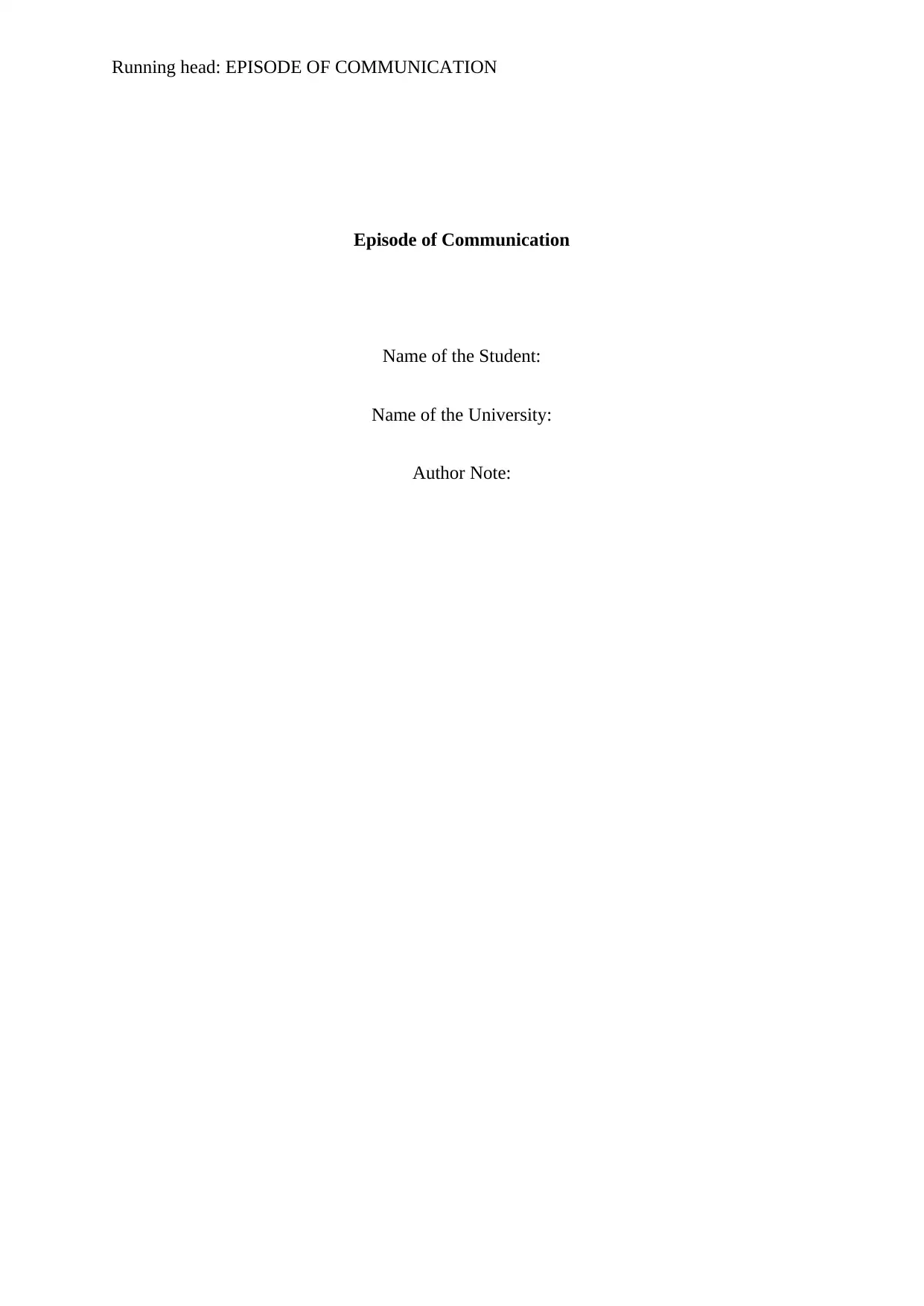
Running head: EPISODE OF COMMUNICATION
Episode of Communication
Name of the Student:
Name of the University:
Author Note:
Episode of Communication
Name of the Student:
Name of the University:
Author Note:
Secure Best Marks with AI Grader
Need help grading? Try our AI Grader for instant feedback on your assignments.
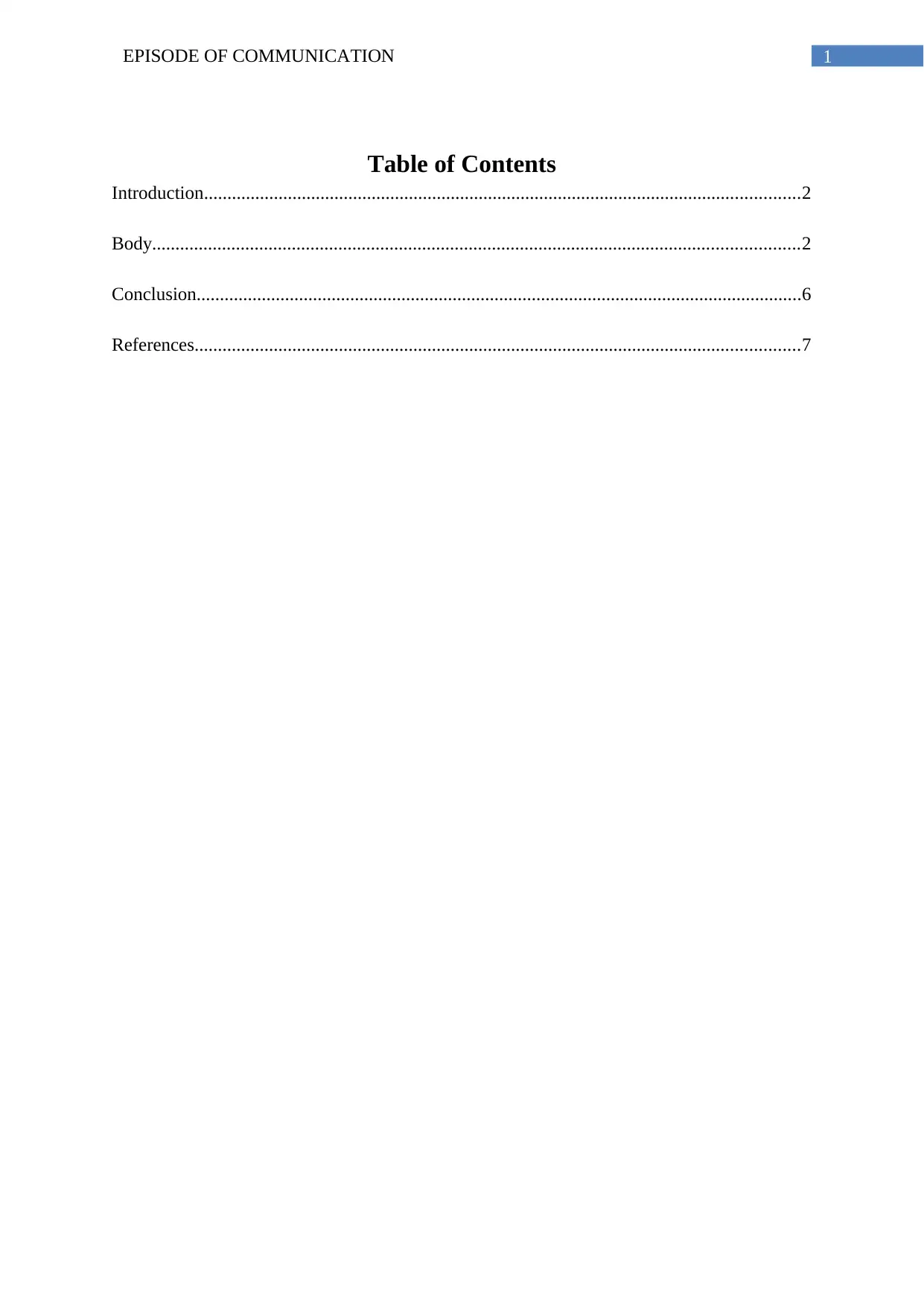
1EPISODE OF COMMUNICATION
Table of Contents
Introduction................................................................................................................................2
Body...........................................................................................................................................2
Conclusion..................................................................................................................................6
References..................................................................................................................................7
Table of Contents
Introduction................................................................................................................................2
Body...........................................................................................................................................2
Conclusion..................................................................................................................................6
References..................................................................................................................................7
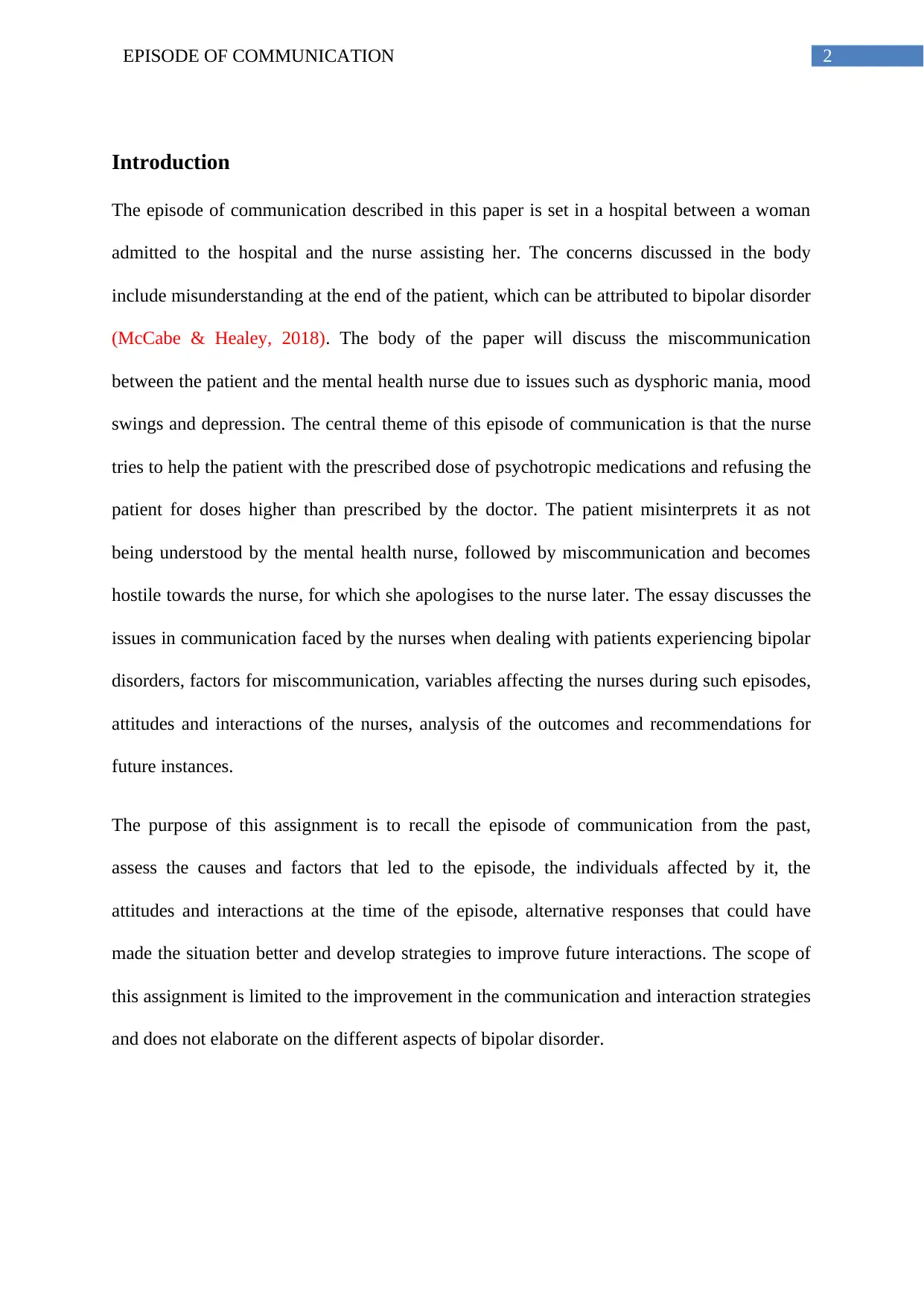
2EPISODE OF COMMUNICATION
Introduction
The episode of communication described in this paper is set in a hospital between a woman
admitted to the hospital and the nurse assisting her. The concerns discussed in the body
include misunderstanding at the end of the patient, which can be attributed to bipolar disorder
(McCabe & Healey, 2018). The body of the paper will discuss the miscommunication
between the patient and the mental health nurse due to issues such as dysphoric mania, mood
swings and depression. The central theme of this episode of communication is that the nurse
tries to help the patient with the prescribed dose of psychotropic medications and refusing the
patient for doses higher than prescribed by the doctor. The patient misinterprets it as not
being understood by the mental health nurse, followed by miscommunication and becomes
hostile towards the nurse, for which she apologises to the nurse later. The essay discusses the
issues in communication faced by the nurses when dealing with patients experiencing bipolar
disorders, factors for miscommunication, variables affecting the nurses during such episodes,
attitudes and interactions of the nurses, analysis of the outcomes and recommendations for
future instances.
The purpose of this assignment is to recall the episode of communication from the past,
assess the causes and factors that led to the episode, the individuals affected by it, the
attitudes and interactions at the time of the episode, alternative responses that could have
made the situation better and develop strategies to improve future interactions. The scope of
this assignment is limited to the improvement in the communication and interaction strategies
and does not elaborate on the different aspects of bipolar disorder.
Introduction
The episode of communication described in this paper is set in a hospital between a woman
admitted to the hospital and the nurse assisting her. The concerns discussed in the body
include misunderstanding at the end of the patient, which can be attributed to bipolar disorder
(McCabe & Healey, 2018). The body of the paper will discuss the miscommunication
between the patient and the mental health nurse due to issues such as dysphoric mania, mood
swings and depression. The central theme of this episode of communication is that the nurse
tries to help the patient with the prescribed dose of psychotropic medications and refusing the
patient for doses higher than prescribed by the doctor. The patient misinterprets it as not
being understood by the mental health nurse, followed by miscommunication and becomes
hostile towards the nurse, for which she apologises to the nurse later. The essay discusses the
issues in communication faced by the nurses when dealing with patients experiencing bipolar
disorders, factors for miscommunication, variables affecting the nurses during such episodes,
attitudes and interactions of the nurses, analysis of the outcomes and recommendations for
future instances.
The purpose of this assignment is to recall the episode of communication from the past,
assess the causes and factors that led to the episode, the individuals affected by it, the
attitudes and interactions at the time of the episode, alternative responses that could have
made the situation better and develop strategies to improve future interactions. The scope of
this assignment is limited to the improvement in the communication and interaction strategies
and does not elaborate on the different aspects of bipolar disorder.
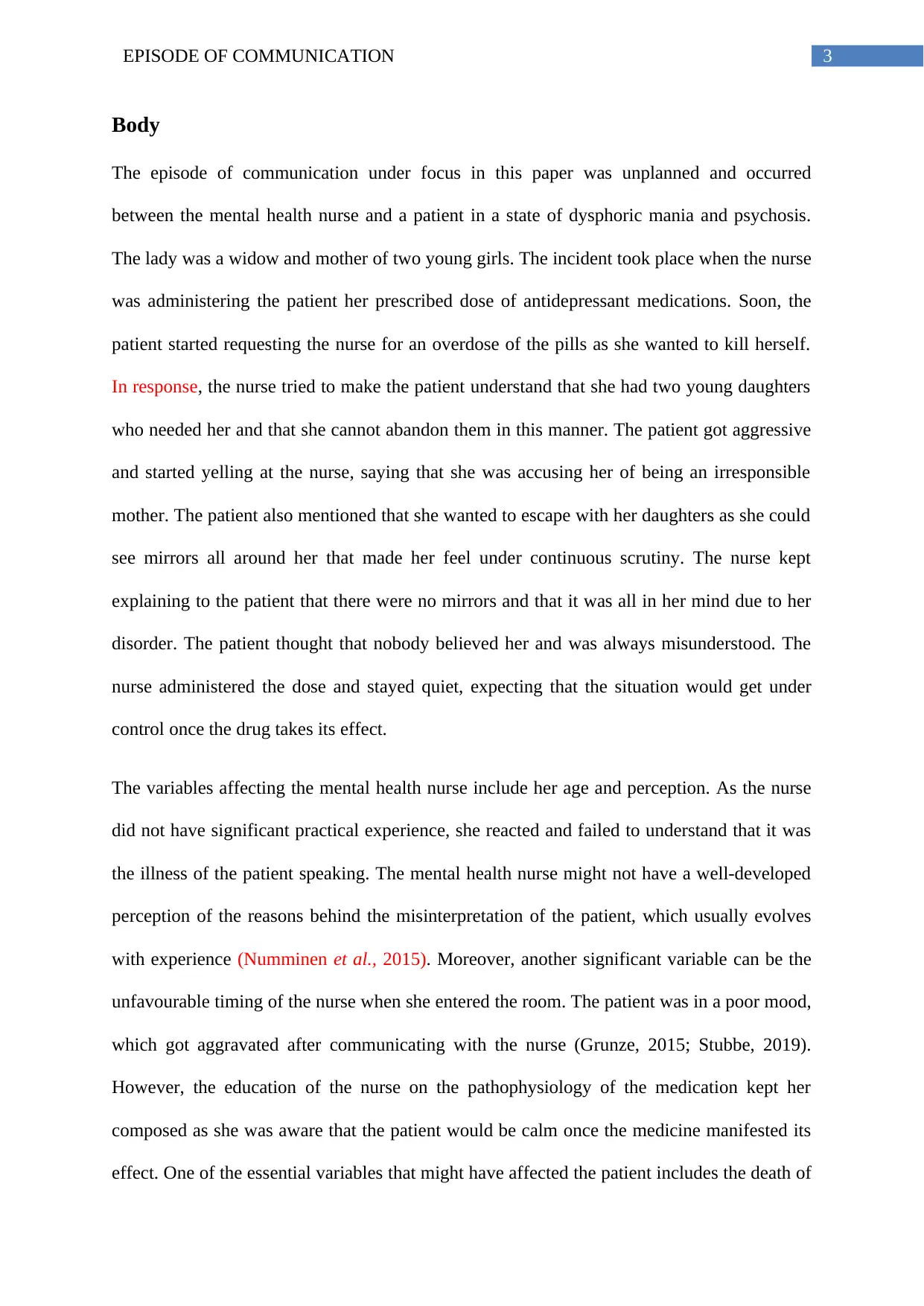
3EPISODE OF COMMUNICATION
Body
The episode of communication under focus in this paper was unplanned and occurred
between the mental health nurse and a patient in a state of dysphoric mania and psychosis.
The lady was a widow and mother of two young girls. The incident took place when the nurse
was administering the patient her prescribed dose of antidepressant medications. Soon, the
patient started requesting the nurse for an overdose of the pills as she wanted to kill herself.
In response, the nurse tried to make the patient understand that she had two young daughters
who needed her and that she cannot abandon them in this manner. The patient got aggressive
and started yelling at the nurse, saying that she was accusing her of being an irresponsible
mother. The patient also mentioned that she wanted to escape with her daughters as she could
see mirrors all around her that made her feel under continuous scrutiny. The nurse kept
explaining to the patient that there were no mirrors and that it was all in her mind due to her
disorder. The patient thought that nobody believed her and was always misunderstood. The
nurse administered the dose and stayed quiet, expecting that the situation would get under
control once the drug takes its effect.
The variables affecting the mental health nurse include her age and perception. As the nurse
did not have significant practical experience, she reacted and failed to understand that it was
the illness of the patient speaking. The mental health nurse might not have a well-developed
perception of the reasons behind the misinterpretation of the patient, which usually evolves
with experience (Numminen et al., 2015). Moreover, another significant variable can be the
unfavourable timing of the nurse when she entered the room. The patient was in a poor mood,
which got aggravated after communicating with the nurse (Grunze, 2015; Stubbe, 2019).
However, the education of the nurse on the pathophysiology of the medication kept her
composed as she was aware that the patient would be calm once the medicine manifested its
effect. One of the essential variables that might have affected the patient includes the death of
Body
The episode of communication under focus in this paper was unplanned and occurred
between the mental health nurse and a patient in a state of dysphoric mania and psychosis.
The lady was a widow and mother of two young girls. The incident took place when the nurse
was administering the patient her prescribed dose of antidepressant medications. Soon, the
patient started requesting the nurse for an overdose of the pills as she wanted to kill herself.
In response, the nurse tried to make the patient understand that she had two young daughters
who needed her and that she cannot abandon them in this manner. The patient got aggressive
and started yelling at the nurse, saying that she was accusing her of being an irresponsible
mother. The patient also mentioned that she wanted to escape with her daughters as she could
see mirrors all around her that made her feel under continuous scrutiny. The nurse kept
explaining to the patient that there were no mirrors and that it was all in her mind due to her
disorder. The patient thought that nobody believed her and was always misunderstood. The
nurse administered the dose and stayed quiet, expecting that the situation would get under
control once the drug takes its effect.
The variables affecting the mental health nurse include her age and perception. As the nurse
did not have significant practical experience, she reacted and failed to understand that it was
the illness of the patient speaking. The mental health nurse might not have a well-developed
perception of the reasons behind the misinterpretation of the patient, which usually evolves
with experience (Numminen et al., 2015). Moreover, another significant variable can be the
unfavourable timing of the nurse when she entered the room. The patient was in a poor mood,
which got aggravated after communicating with the nurse (Grunze, 2015; Stubbe, 2019).
However, the education of the nurse on the pathophysiology of the medication kept her
composed as she was aware that the patient would be calm once the medicine manifested its
effect. One of the essential variables that might have affected the patient includes the death of
Secure Best Marks with AI Grader
Need help grading? Try our AI Grader for instant feedback on your assignments.
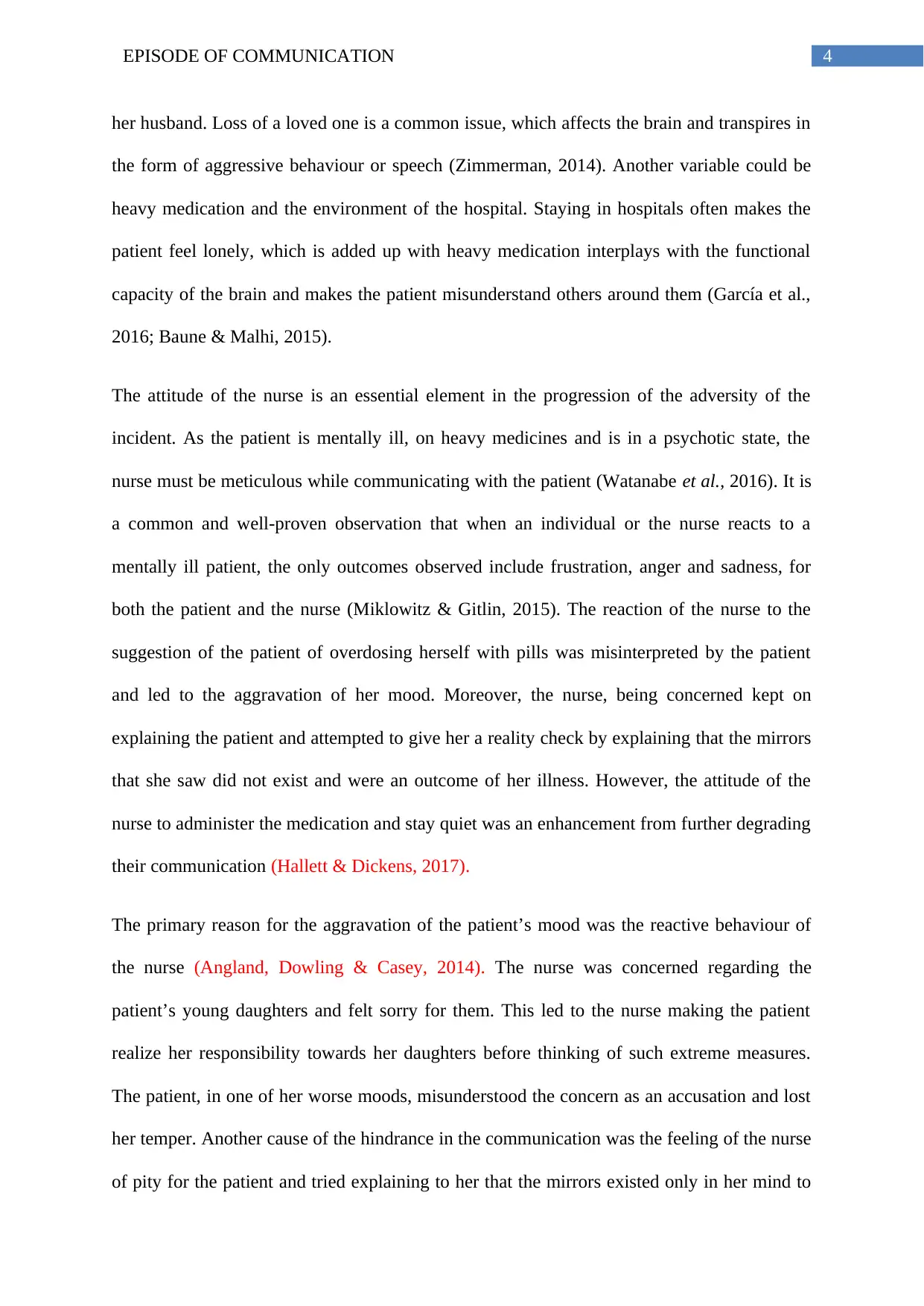
4EPISODE OF COMMUNICATION
her husband. Loss of a loved one is a common issue, which affects the brain and transpires in
the form of aggressive behaviour or speech (Zimmerman, 2014). Another variable could be
heavy medication and the environment of the hospital. Staying in hospitals often makes the
patient feel lonely, which is added up with heavy medication interplays with the functional
capacity of the brain and makes the patient misunderstand others around them (García et al.,
2016; Baune & Malhi, 2015).
The attitude of the nurse is an essential element in the progression of the adversity of the
incident. As the patient is mentally ill, on heavy medicines and is in a psychotic state, the
nurse must be meticulous while communicating with the patient (Watanabe et al., 2016). It is
a common and well-proven observation that when an individual or the nurse reacts to a
mentally ill patient, the only outcomes observed include frustration, anger and sadness, for
both the patient and the nurse (Miklowitz & Gitlin, 2015). The reaction of the nurse to the
suggestion of the patient of overdosing herself with pills was misinterpreted by the patient
and led to the aggravation of her mood. Moreover, the nurse, being concerned kept on
explaining the patient and attempted to give her a reality check by explaining that the mirrors
that she saw did not exist and were an outcome of her illness. However, the attitude of the
nurse to administer the medication and stay quiet was an enhancement from further degrading
their communication (Hallett & Dickens, 2017).
The primary reason for the aggravation of the patient’s mood was the reactive behaviour of
the nurse (Angland, Dowling & Casey, 2014). The nurse was concerned regarding the
patient’s young daughters and felt sorry for them. This led to the nurse making the patient
realize her responsibility towards her daughters before thinking of such extreme measures.
The patient, in one of her worse moods, misunderstood the concern as an accusation and lost
her temper. Another cause of the hindrance in the communication was the feeling of the nurse
of pity for the patient and tried explaining to her that the mirrors existed only in her mind to
her husband. Loss of a loved one is a common issue, which affects the brain and transpires in
the form of aggressive behaviour or speech (Zimmerman, 2014). Another variable could be
heavy medication and the environment of the hospital. Staying in hospitals often makes the
patient feel lonely, which is added up with heavy medication interplays with the functional
capacity of the brain and makes the patient misunderstand others around them (García et al.,
2016; Baune & Malhi, 2015).
The attitude of the nurse is an essential element in the progression of the adversity of the
incident. As the patient is mentally ill, on heavy medicines and is in a psychotic state, the
nurse must be meticulous while communicating with the patient (Watanabe et al., 2016). It is
a common and well-proven observation that when an individual or the nurse reacts to a
mentally ill patient, the only outcomes observed include frustration, anger and sadness, for
both the patient and the nurse (Miklowitz & Gitlin, 2015). The reaction of the nurse to the
suggestion of the patient of overdosing herself with pills was misinterpreted by the patient
and led to the aggravation of her mood. Moreover, the nurse, being concerned kept on
explaining the patient and attempted to give her a reality check by explaining that the mirrors
that she saw did not exist and were an outcome of her illness. However, the attitude of the
nurse to administer the medication and stay quiet was an enhancement from further degrading
their communication (Hallett & Dickens, 2017).
The primary reason for the aggravation of the patient’s mood was the reactive behaviour of
the nurse (Angland, Dowling & Casey, 2014). The nurse was concerned regarding the
patient’s young daughters and felt sorry for them. This led to the nurse making the patient
realize her responsibility towards her daughters before thinking of such extreme measures.
The patient, in one of her worse moods, misunderstood the concern as an accusation and lost
her temper. Another cause of the hindrance in the communication was the feeling of the nurse
of pity for the patient and tried explaining to her that the mirrors existed only in her mind to
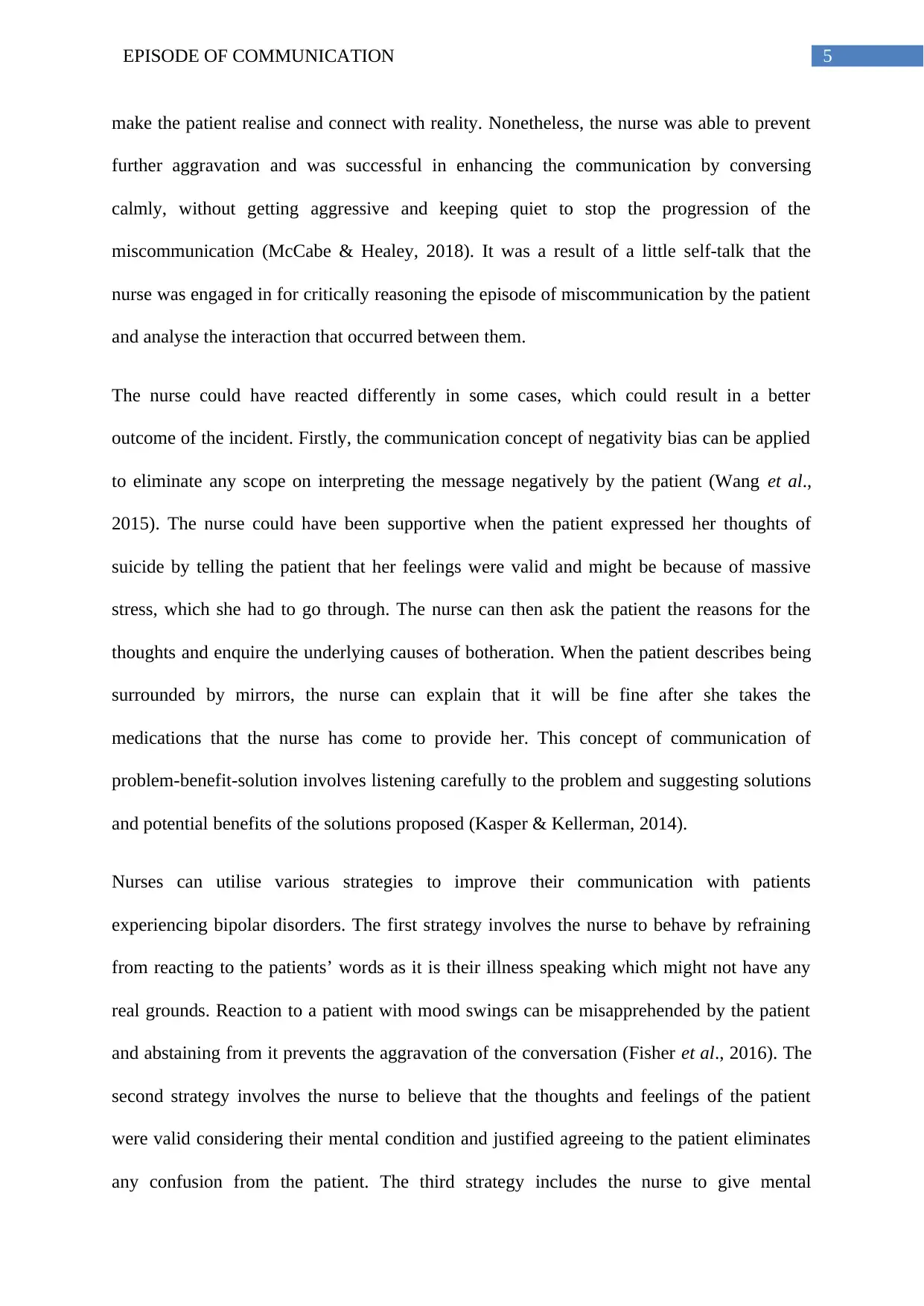
5EPISODE OF COMMUNICATION
make the patient realise and connect with reality. Nonetheless, the nurse was able to prevent
further aggravation and was successful in enhancing the communication by conversing
calmly, without getting aggressive and keeping quiet to stop the progression of the
miscommunication (McCabe & Healey, 2018). It was a result of a little self-talk that the
nurse was engaged in for critically reasoning the episode of miscommunication by the patient
and analyse the interaction that occurred between them.
The nurse could have reacted differently in some cases, which could result in a better
outcome of the incident. Firstly, the communication concept of negativity bias can be applied
to eliminate any scope on interpreting the message negatively by the patient (Wang et al.,
2015). The nurse could have been supportive when the patient expressed her thoughts of
suicide by telling the patient that her feelings were valid and might be because of massive
stress, which she had to go through. The nurse can then ask the patient the reasons for the
thoughts and enquire the underlying causes of botheration. When the patient describes being
surrounded by mirrors, the nurse can explain that it will be fine after she takes the
medications that the nurse has come to provide her. This concept of communication of
problem-benefit-solution involves listening carefully to the problem and suggesting solutions
and potential benefits of the solutions proposed (Kasper & Kellerman, 2014).
Nurses can utilise various strategies to improve their communication with patients
experiencing bipolar disorders. The first strategy involves the nurse to behave by refraining
from reacting to the patients’ words as it is their illness speaking which might not have any
real grounds. Reaction to a patient with mood swings can be misapprehended by the patient
and abstaining from it prevents the aggravation of the conversation (Fisher et al., 2016). The
second strategy involves the nurse to believe that the thoughts and feelings of the patient
were valid considering their mental condition and justified agreeing to the patient eliminates
any confusion from the patient. The third strategy includes the nurse to give mental
make the patient realise and connect with reality. Nonetheless, the nurse was able to prevent
further aggravation and was successful in enhancing the communication by conversing
calmly, without getting aggressive and keeping quiet to stop the progression of the
miscommunication (McCabe & Healey, 2018). It was a result of a little self-talk that the
nurse was engaged in for critically reasoning the episode of miscommunication by the patient
and analyse the interaction that occurred between them.
The nurse could have reacted differently in some cases, which could result in a better
outcome of the incident. Firstly, the communication concept of negativity bias can be applied
to eliminate any scope on interpreting the message negatively by the patient (Wang et al.,
2015). The nurse could have been supportive when the patient expressed her thoughts of
suicide by telling the patient that her feelings were valid and might be because of massive
stress, which she had to go through. The nurse can then ask the patient the reasons for the
thoughts and enquire the underlying causes of botheration. When the patient describes being
surrounded by mirrors, the nurse can explain that it will be fine after she takes the
medications that the nurse has come to provide her. This concept of communication of
problem-benefit-solution involves listening carefully to the problem and suggesting solutions
and potential benefits of the solutions proposed (Kasper & Kellerman, 2014).
Nurses can utilise various strategies to improve their communication with patients
experiencing bipolar disorders. The first strategy involves the nurse to behave by refraining
from reacting to the patients’ words as it is their illness speaking which might not have any
real grounds. Reaction to a patient with mood swings can be misapprehended by the patient
and abstaining from it prevents the aggravation of the conversation (Fisher et al., 2016). The
second strategy involves the nurse to believe that the thoughts and feelings of the patient
were valid considering their mental condition and justified agreeing to the patient eliminates
any confusion from the patient. The third strategy includes the nurse to give mental
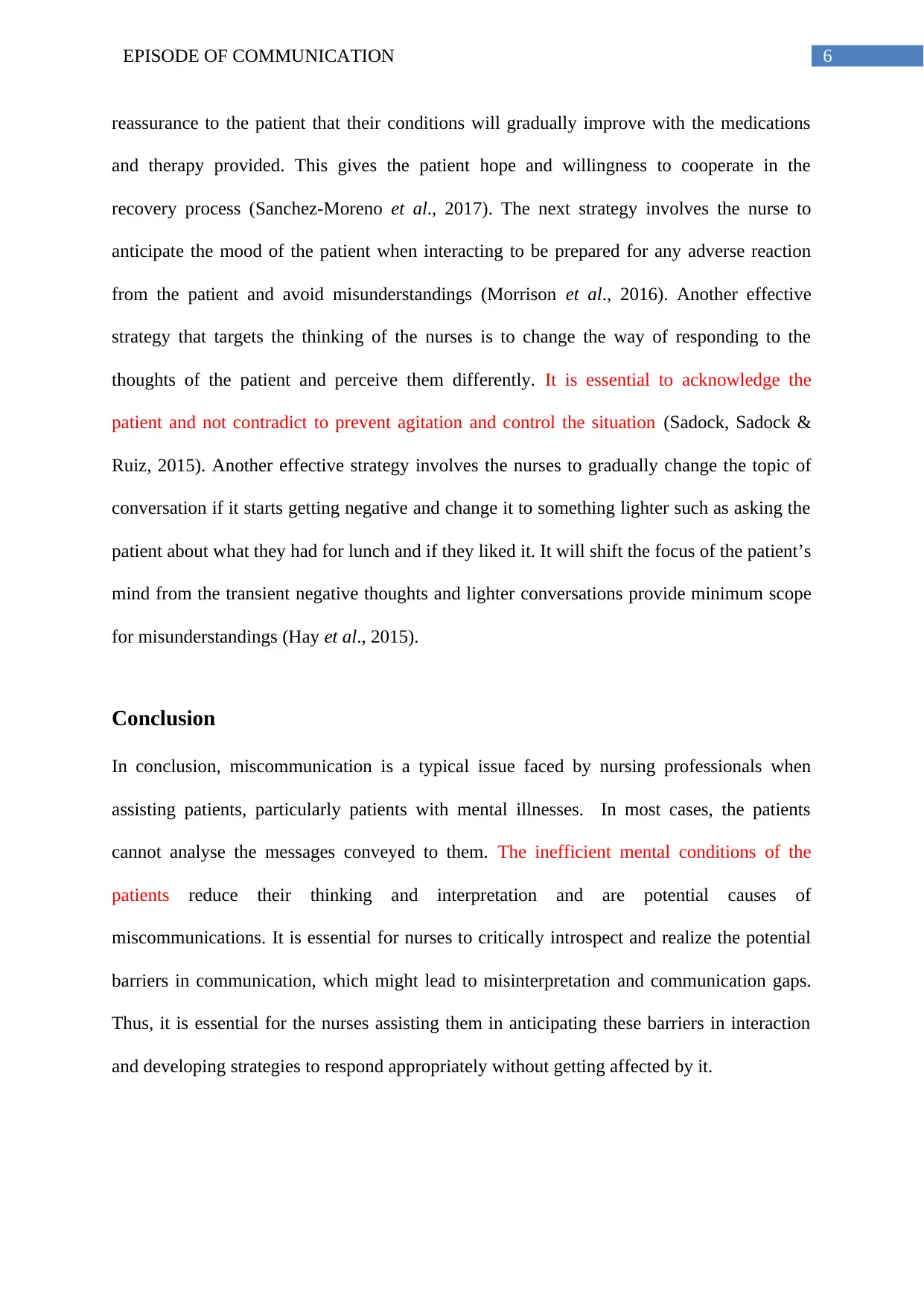
6EPISODE OF COMMUNICATION
reassurance to the patient that their conditions will gradually improve with the medications
and therapy provided. This gives the patient hope and willingness to cooperate in the
recovery process (Sanchez-Moreno et al., 2017). The next strategy involves the nurse to
anticipate the mood of the patient when interacting to be prepared for any adverse reaction
from the patient and avoid misunderstandings (Morrison et al., 2016). Another effective
strategy that targets the thinking of the nurses is to change the way of responding to the
thoughts of the patient and perceive them differently. It is essential to acknowledge the
patient and not contradict to prevent agitation and control the situation (Sadock, Sadock &
Ruiz, 2015). Another effective strategy involves the nurses to gradually change the topic of
conversation if it starts getting negative and change it to something lighter such as asking the
patient about what they had for lunch and if they liked it. It will shift the focus of the patient’s
mind from the transient negative thoughts and lighter conversations provide minimum scope
for misunderstandings (Hay et al., 2015).
Conclusion
In conclusion, miscommunication is a typical issue faced by nursing professionals when
assisting patients, particularly patients with mental illnesses. In most cases, the patients
cannot analyse the messages conveyed to them. The inefficient mental conditions of the
patients reduce their thinking and interpretation and are potential causes of
miscommunications. It is essential for nurses to critically introspect and realize the potential
barriers in communication, which might lead to misinterpretation and communication gaps.
Thus, it is essential for the nurses assisting them in anticipating these barriers in interaction
and developing strategies to respond appropriately without getting affected by it.
reassurance to the patient that their conditions will gradually improve with the medications
and therapy provided. This gives the patient hope and willingness to cooperate in the
recovery process (Sanchez-Moreno et al., 2017). The next strategy involves the nurse to
anticipate the mood of the patient when interacting to be prepared for any adverse reaction
from the patient and avoid misunderstandings (Morrison et al., 2016). Another effective
strategy that targets the thinking of the nurses is to change the way of responding to the
thoughts of the patient and perceive them differently. It is essential to acknowledge the
patient and not contradict to prevent agitation and control the situation (Sadock, Sadock &
Ruiz, 2015). Another effective strategy involves the nurses to gradually change the topic of
conversation if it starts getting negative and change it to something lighter such as asking the
patient about what they had for lunch and if they liked it. It will shift the focus of the patient’s
mind from the transient negative thoughts and lighter conversations provide minimum scope
for misunderstandings (Hay et al., 2015).
Conclusion
In conclusion, miscommunication is a typical issue faced by nursing professionals when
assisting patients, particularly patients with mental illnesses. In most cases, the patients
cannot analyse the messages conveyed to them. The inefficient mental conditions of the
patients reduce their thinking and interpretation and are potential causes of
miscommunications. It is essential for nurses to critically introspect and realize the potential
barriers in communication, which might lead to misinterpretation and communication gaps.
Thus, it is essential for the nurses assisting them in anticipating these barriers in interaction
and developing strategies to respond appropriately without getting affected by it.
Paraphrase This Document
Need a fresh take? Get an instant paraphrase of this document with our AI Paraphraser
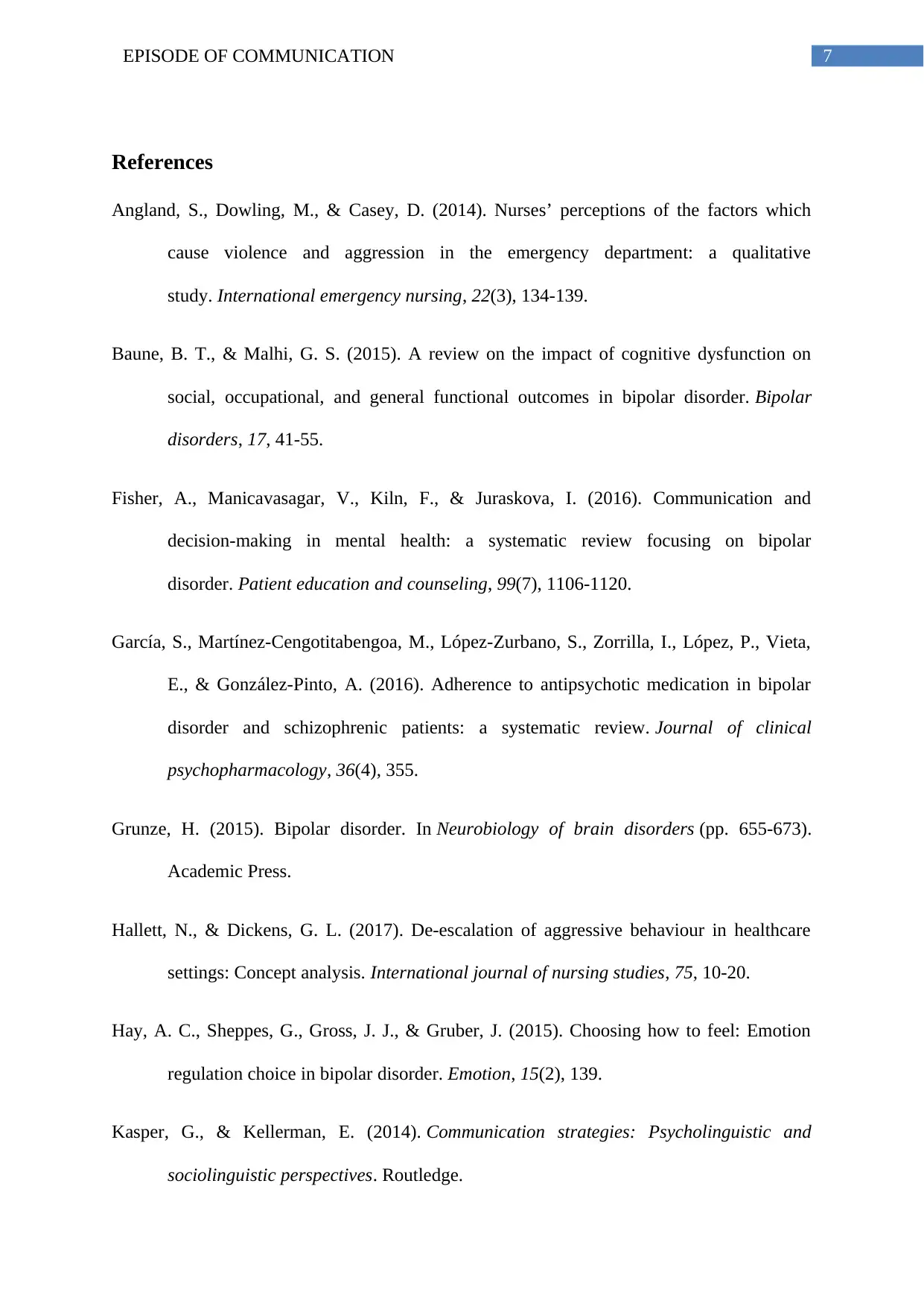
7EPISODE OF COMMUNICATION
References
Angland, S., Dowling, M., & Casey, D. (2014). Nurses’ perceptions of the factors which
cause violence and aggression in the emergency department: a qualitative
study. International emergency nursing, 22(3), 134-139.
Baune, B. T., & Malhi, G. S. (2015). A review on the impact of cognitive dysfunction on
social, occupational, and general functional outcomes in bipolar disorder. Bipolar
disorders, 17, 41-55.
Fisher, A., Manicavasagar, V., Kiln, F., & Juraskova, I. (2016). Communication and
decision-making in mental health: a systematic review focusing on bipolar
disorder. Patient education and counseling, 99(7), 1106-1120.
García, S., Martínez-Cengotitabengoa, M., López-Zurbano, S., Zorrilla, I., López, P., Vieta,
E., & González-Pinto, A. (2016). Adherence to antipsychotic medication in bipolar
disorder and schizophrenic patients: a systematic review. Journal of clinical
psychopharmacology, 36(4), 355.
Grunze, H. (2015). Bipolar disorder. In Neurobiology of brain disorders (pp. 655-673).
Academic Press.
Hallett, N., & Dickens, G. L. (2017). De-escalation of aggressive behaviour in healthcare
settings: Concept analysis. International journal of nursing studies, 75, 10-20.
Hay, A. C., Sheppes, G., Gross, J. J., & Gruber, J. (2015). Choosing how to feel: Emotion
regulation choice in bipolar disorder. Emotion, 15(2), 139.
Kasper, G., & Kellerman, E. (2014). Communication strategies: Psycholinguistic and
sociolinguistic perspectives. Routledge.
References
Angland, S., Dowling, M., & Casey, D. (2014). Nurses’ perceptions of the factors which
cause violence and aggression in the emergency department: a qualitative
study. International emergency nursing, 22(3), 134-139.
Baune, B. T., & Malhi, G. S. (2015). A review on the impact of cognitive dysfunction on
social, occupational, and general functional outcomes in bipolar disorder. Bipolar
disorders, 17, 41-55.
Fisher, A., Manicavasagar, V., Kiln, F., & Juraskova, I. (2016). Communication and
decision-making in mental health: a systematic review focusing on bipolar
disorder. Patient education and counseling, 99(7), 1106-1120.
García, S., Martínez-Cengotitabengoa, M., López-Zurbano, S., Zorrilla, I., López, P., Vieta,
E., & González-Pinto, A. (2016). Adherence to antipsychotic medication in bipolar
disorder and schizophrenic patients: a systematic review. Journal of clinical
psychopharmacology, 36(4), 355.
Grunze, H. (2015). Bipolar disorder. In Neurobiology of brain disorders (pp. 655-673).
Academic Press.
Hallett, N., & Dickens, G. L. (2017). De-escalation of aggressive behaviour in healthcare
settings: Concept analysis. International journal of nursing studies, 75, 10-20.
Hay, A. C., Sheppes, G., Gross, J. J., & Gruber, J. (2015). Choosing how to feel: Emotion
regulation choice in bipolar disorder. Emotion, 15(2), 139.
Kasper, G., & Kellerman, E. (2014). Communication strategies: Psycholinguistic and
sociolinguistic perspectives. Routledge.
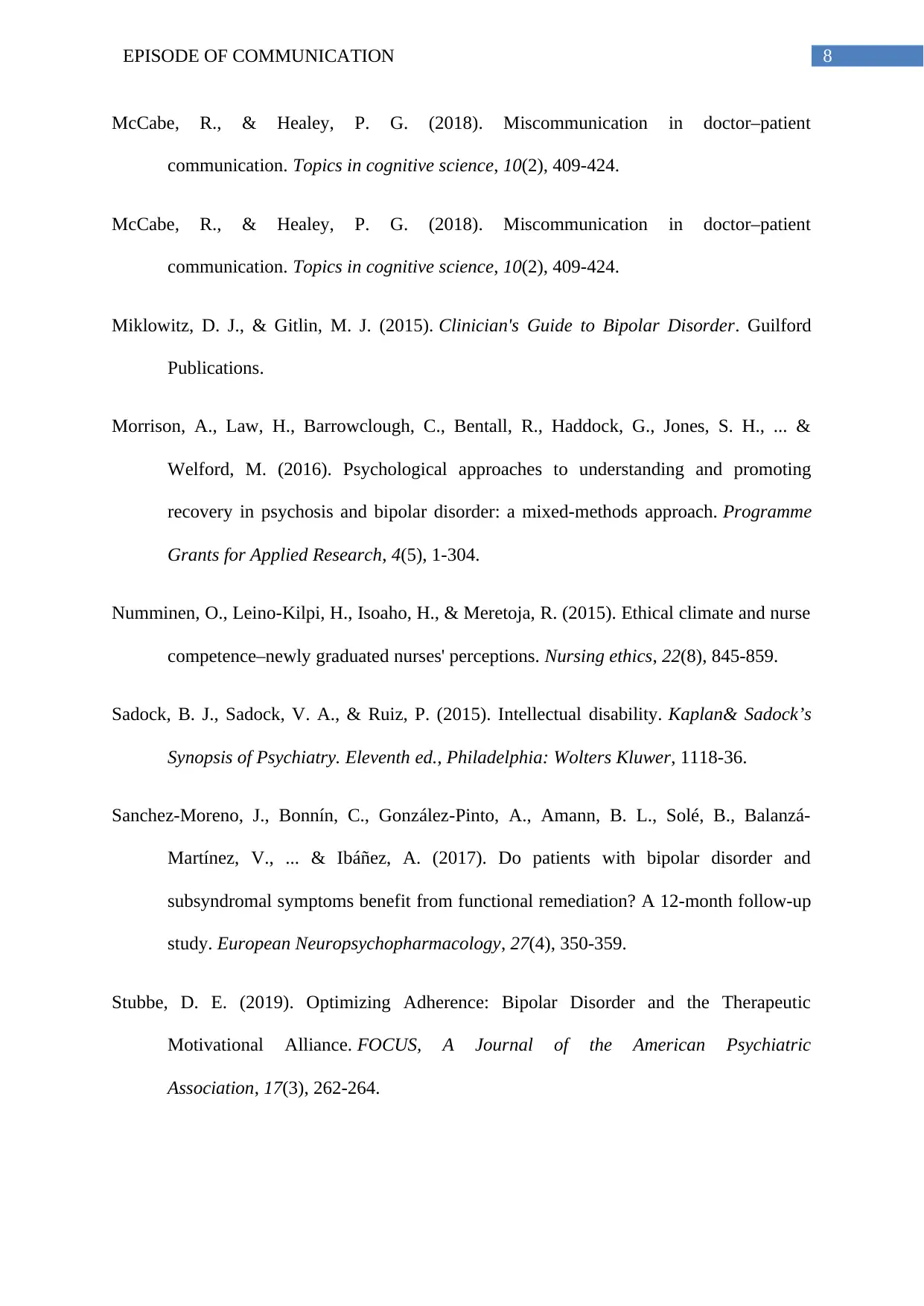
8EPISODE OF COMMUNICATION
McCabe, R., & Healey, P. G. (2018). Miscommunication in doctor–patient
communication. Topics in cognitive science, 10(2), 409-424.
McCabe, R., & Healey, P. G. (2018). Miscommunication in doctor–patient
communication. Topics in cognitive science, 10(2), 409-424.
Miklowitz, D. J., & Gitlin, M. J. (2015). Clinician's Guide to Bipolar Disorder. Guilford
Publications.
Morrison, A., Law, H., Barrowclough, C., Bentall, R., Haddock, G., Jones, S. H., ... &
Welford, M. (2016). Psychological approaches to understanding and promoting
recovery in psychosis and bipolar disorder: a mixed-methods approach. Programme
Grants for Applied Research, 4(5), 1-304.
Numminen, O., Leino-Kilpi, H., Isoaho, H., & Meretoja, R. (2015). Ethical climate and nurse
competence–newly graduated nurses' perceptions. Nursing ethics, 22(8), 845-859.
Sadock, B. J., Sadock, V. A., & Ruiz, P. (2015). Intellectual disability. Kaplan& Sadock’s
Synopsis of Psychiatry. Eleventh ed., Philadelphia: Wolters Kluwer, 1118-36.
Sanchez-Moreno, J., Bonnín, C., González-Pinto, A., Amann, B. L., Solé, B., Balanzá-
Martínez, V., ... & Ibáñez, A. (2017). Do patients with bipolar disorder and
subsyndromal symptoms benefit from functional remediation? A 12-month follow-up
study. European Neuropsychopharmacology, 27(4), 350-359.
Stubbe, D. E. (2019). Optimizing Adherence: Bipolar Disorder and the Therapeutic
Motivational Alliance. FOCUS, A Journal of the American Psychiatric
Association, 17(3), 262-264.
McCabe, R., & Healey, P. G. (2018). Miscommunication in doctor–patient
communication. Topics in cognitive science, 10(2), 409-424.
McCabe, R., & Healey, P. G. (2018). Miscommunication in doctor–patient
communication. Topics in cognitive science, 10(2), 409-424.
Miklowitz, D. J., & Gitlin, M. J. (2015). Clinician's Guide to Bipolar Disorder. Guilford
Publications.
Morrison, A., Law, H., Barrowclough, C., Bentall, R., Haddock, G., Jones, S. H., ... &
Welford, M. (2016). Psychological approaches to understanding and promoting
recovery in psychosis and bipolar disorder: a mixed-methods approach. Programme
Grants for Applied Research, 4(5), 1-304.
Numminen, O., Leino-Kilpi, H., Isoaho, H., & Meretoja, R. (2015). Ethical climate and nurse
competence–newly graduated nurses' perceptions. Nursing ethics, 22(8), 845-859.
Sadock, B. J., Sadock, V. A., & Ruiz, P. (2015). Intellectual disability. Kaplan& Sadock’s
Synopsis of Psychiatry. Eleventh ed., Philadelphia: Wolters Kluwer, 1118-36.
Sanchez-Moreno, J., Bonnín, C., González-Pinto, A., Amann, B. L., Solé, B., Balanzá-
Martínez, V., ... & Ibáñez, A. (2017). Do patients with bipolar disorder and
subsyndromal symptoms benefit from functional remediation? A 12-month follow-up
study. European Neuropsychopharmacology, 27(4), 350-359.
Stubbe, D. E. (2019). Optimizing Adherence: Bipolar Disorder and the Therapeutic
Motivational Alliance. FOCUS, A Journal of the American Psychiatric
Association, 17(3), 262-264.
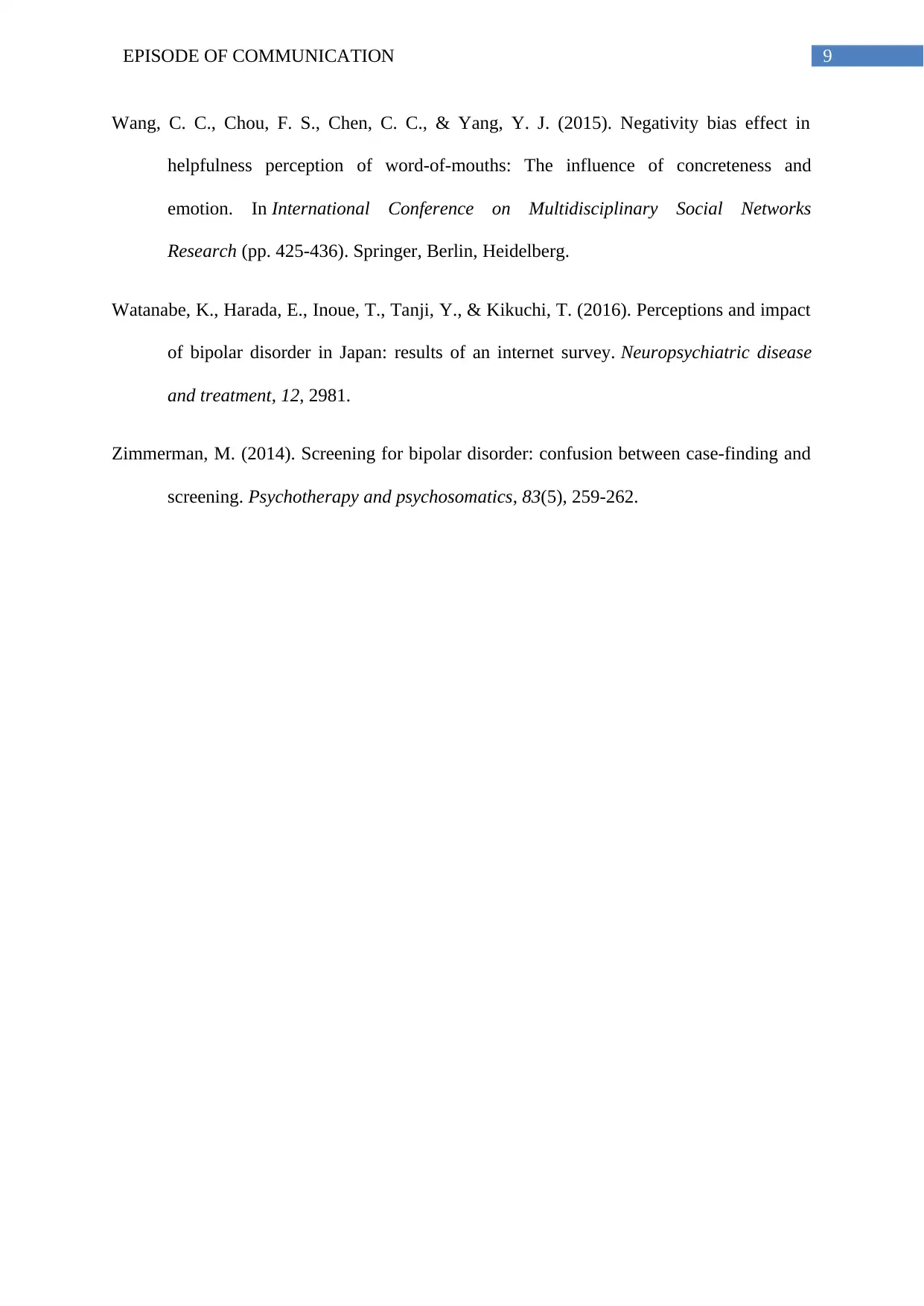
9EPISODE OF COMMUNICATION
Wang, C. C., Chou, F. S., Chen, C. C., & Yang, Y. J. (2015). Negativity bias effect in
helpfulness perception of word-of-mouths: The influence of concreteness and
emotion. In International Conference on Multidisciplinary Social Networks
Research (pp. 425-436). Springer, Berlin, Heidelberg.
Watanabe, K., Harada, E., Inoue, T., Tanji, Y., & Kikuchi, T. (2016). Perceptions and impact
of bipolar disorder in Japan: results of an internet survey. Neuropsychiatric disease
and treatment, 12, 2981.
Zimmerman, M. (2014). Screening for bipolar disorder: confusion between case-finding and
screening. Psychotherapy and psychosomatics, 83(5), 259-262.
Wang, C. C., Chou, F. S., Chen, C. C., & Yang, Y. J. (2015). Negativity bias effect in
helpfulness perception of word-of-mouths: The influence of concreteness and
emotion. In International Conference on Multidisciplinary Social Networks
Research (pp. 425-436). Springer, Berlin, Heidelberg.
Watanabe, K., Harada, E., Inoue, T., Tanji, Y., & Kikuchi, T. (2016). Perceptions and impact
of bipolar disorder in Japan: results of an internet survey. Neuropsychiatric disease
and treatment, 12, 2981.
Zimmerman, M. (2014). Screening for bipolar disorder: confusion between case-finding and
screening. Psychotherapy and psychosomatics, 83(5), 259-262.
1 out of 10
Related Documents
Your All-in-One AI-Powered Toolkit for Academic Success.
+13062052269
info@desklib.com
Available 24*7 on WhatsApp / Email
![[object Object]](/_next/static/media/star-bottom.7253800d.svg)
Unlock your academic potential
© 2024 | Zucol Services PVT LTD | All rights reserved.





